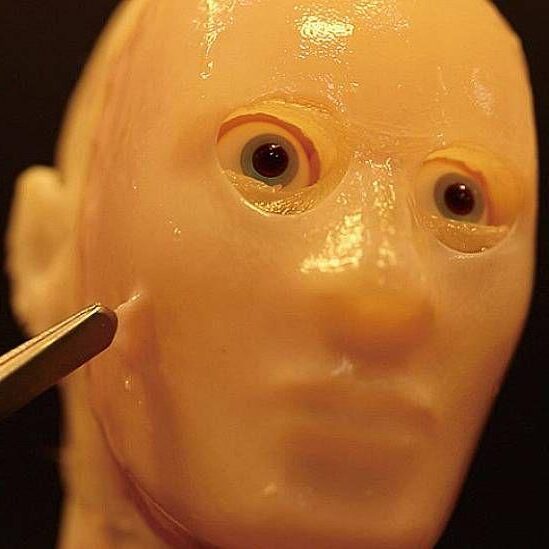BTN News: In a groundbreaking development, Japanese scientists have successfully grown living skin that can be attached to robots, paving the way for more realistic humanoid robots capable of genuine facial expressions. Researchers from the University of Tokyo have managed to recreate human-like skin using living cells, overcoming previous challenges associated with affixing delicate materials to robotic surfaces. This innovation marks a significant leap towards robots that not only look human but can also move and emote in ways that are strikingly lifelike.
The team’s approach mimics the natural human skin structure, featuring self-healing properties that promise to make humanoid robots more durable and functional. The advancement, described in a recent study published in Cell Reports Physical Science, may have far-reaching implications for robotics, artificial intelligence, and human-robot interaction.
A New Era for Humanoid Robots: The Secret is in the Skin
Developing realistic facial expressions in robots has long been a challenge. Previous attempts to attach synthetic skin to robots resulted in frequent tearing and mechanical failures, limiting their range of movement and expression. Traditional methods, like using miniganchos or hooks, caused damage when the robot’s face moved, leading researchers to seek more sophisticated solutions.
To overcome these issues, the scientists at the University of Tokyo turned to human biology for inspiration. In humans, the skin is connected to underlying structures through ligaments made of flexible collagen and elastin fibers. Mimicking this, the team created numerous tiny perforations in the robot’s surface and filled them with a gel containing collagen, allowing the skin to adhere securely and flexibly. The result? A more natural appearance and movement without the risk of tearing or peeling.
The Power of Realistic Facial Expressions
The development of artificial skin that can smile, frown, or show surprise is more than just a technical achievement—it represents a major step toward creating robots that people can relate to on a human level. “By imitating the skin and ligament structures found in humans, and using specially designed V-shaped perforations in solid materials, we found a way to attach skin to complex surfaces,” explained Shoji Takeuchi, the lead researcher.
The new skin not only feels soft and natural but is also capable of self-repair. When cut or damaged, the skin can heal itself, a feature that drastically reduces the need for constant maintenance or replacement, thereby making robots more practical and cost-effective for everyday use.
Challenges Ahead: Perfecting Human-Like Expressions
While the achievement is impressive, the researchers acknowledge that creating truly human-like robots will require further work. “Another significant challenge is developing more sophisticated actuators or artificial muscles to replicate human expressions more closely,” said Professor Takeuchi. The team believes it may take many more years of testing and refinement before this technology is ready for widespread application.
For now, the focus is on refining the durability and realism of the skin itself. The goal is to create a surface that can withstand various movements and environmental factors without degrading, allowing for the creation of humanoids that can function in diverse settings—from customer service to healthcare.
A Step Closer to Lifelike Humanoids
By integrating advanced tissue engineering with robotics, this research brings us closer to a future where robots are nearly indistinguishable from humans. The living skin, made from real cells, can stretch, flex, and repair itself, offering a level of authenticity that was previously unattainable in robotics. This breakthrough not only sets a new standard for human-robot interaction but also opens the door to countless possibilities in fields such as medicine, caregiving, and entertainment.
The use of living cells to create artificial skin is an innovative approach that addresses one of the biggest challenges in humanoid robotics—creating robots that look, feel, and move like real humans. As this technology continues to evolve, the potential applications for lifelike humanoids will only expand.
Looking to the Future: What’s Next for Humanoid Robots?
The University of Tokyo’s work has attracted global attention, but researchers are quick to remind us that there is still much to learn. The next steps involve integrating this self-healing skin with advanced sensors and actuators that can mimic the subtleties of human facial expressions. This integration will be key to making robots appear genuinely human in their interactions.
In the meantime, scientists continue to test the skin’s ability to withstand wear and tear, and its effectiveness in various environmental conditions. As the technology matures, the prospect of having robots that can engage with humans in more natural and meaningful ways becomes increasingly plausible.
Conclusion: Paving the Way for Future Innovations
With the successful development of self-healing living skin, Japanese scientists have made a significant contribution to the field of robotics, setting the stage for future advancements in creating more realistic, expressive, and durable humanoid robots. This breakthrough not only enhances the robots’ aesthetic appeal but also their functional capabilities, signaling a new era in human-robot interaction.
As research continues, we can look forward to a future where humanoid robots become a common and natural part of our everyday lives, capable of engaging with us in ways we once only imagined in science fiction.


